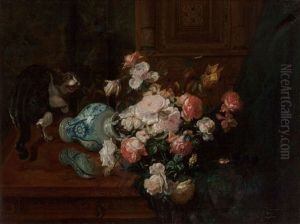Gustave Emile Marchegay Paintings
Gustave Emile Marchegay, though not a household name in the annals of art history, was a French painter and lithographer whose contributions to 19th-century European art provide insight into the period's aesthetic transitions and cultural mores. Born in 1825, Marchegay's life and career were set against the backdrop of a rapidly changing France, marked by the tumult of political upheaval, the flowering of the Romantic movement, and the dawn of modernism. His work, though less documented than that of his contemporaries, reflects the eclectic tastes and evolving styles of this vibrant era. Marchegay's artistic journey began at a time when the Romantic ideals of emotion and nature's sublime were giving way to Realist depictions of everyday life and Impressionist experiments with light and color. Trained possibly in the traditional academies, which emphasized classical forms and historical subjects, Marchegay, like many artists of his generation, would have been exposed to the shifting currents of artistic thought, from the strictures of academic art to the burgeoning movements that sought to break free from established conventions. Despite the scarcity of detailed records on his career, it is likely that Marchegay's oeuvre included landscape and genre scenes, possibly rendered in the detailed and meticulous style characteristic of mid-19th-century French art. His work as a lithographer also suggests an engagement with the popular and commercial aspects of art, a field that was expanding rapidly during his lifetime due to technological advances in printmaking. Lithography, with its capacity for mass production, played a crucial role in disseminating visual culture and the ideas of the avant-garde. Marchegay's death in 1871 occurred at a moment of profound transformation in French society and art. The Franco-Prussian War (1870-1871) and the Commune de Paris had just shaken the nation, leading to a period of introspection and innovation among artists. While Marchegay did not live to see the full flowering of Impressionism and the subsequent movements that would redefine Western art, his works remain as markers of the transitional period in which he lived and created. In the absence of extensive documentation or a significant body of surviving works, Gustave Emile Marchegay's contribution to art history is a reminder of the many talented artists whose lives and works are overshadowed by their more famous peers, yet who collectively contributed to the rich tapestry of 19th-century European art.

